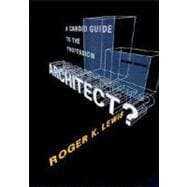
| Preface | p. xi |
| Acknowledgments | p. xiii |
| Introduction | p. xv |
| To Be or Not to Be... an Architect? | |
| Why Be an Architect? | p. 3 |
| Money and Lifestyle | |
| Social Status | |
| Fame | |
| Immortality | |
| Contributing to Culture | |
| Helping and Teaching Others | |
| The Rewards of Creativity and Intellectual Fulfillment | |
| Love of Drawing | |
| Fulfilling the Dictates of Personality | |
| Freedom to Do Your Own Thing | |
| Why Not to Be an Architect | p. 19 |
| The Odds of Making It | |
| Lack of Work | |
| Competition | |
| Inadequate Compensation | |
| Ego Vulnerability | |
| Getting Lost in the Crowd | |
| The Risks of Envy | |
| Lack of Power & Influence | |
| Anxiety, Disappointment & Depression | |
| Lack of Talent, Passion & Dedication | |
| Becoming an Architect | |
| The Structure of Architectural Education | p. 39 |
| Program Types | |
| Curricular Content-Design, The Design Studio, History and Theory, Technology, Structures, Materials and Methods of Construction, Environmental Controls, Computer-aided Design, Management, Electives | |
| Experiencing Architectural School | p. 61 |
| The First Year and Work Load Shock | |
| New Values, New Language | |
| Competition and Grades | |
| Pencilphobia | |
| The Culture and Community of Architectural School | |
| The Jury System | |
| Other Traditions | |
| Professors and What They Profess | p. 89 |
| The Professors | |
| Some -Isms and -Ologies--Morphology, Historicism, Historic Preservation, Technology, Deconstructionism, Sociology and Psychology, Functionalism, Methodology, Ecology, Urbanism, Symbology | |
| Architectural Schools: Choosing and Being Chosen | p. 123 |
| Preparing for School | |
| Choosing Schools--Location, Program Type, Reputation, Resources, Cost, Students, Faculty, Program Directions | |
| The Admissions Process--The Portfolio, Interviews, Reference, Grades, Exams, Timing, Financial Aid, Admission Odds | |
| After School, What? | p. 141 |
| Internship | |
| Becoming a Registered Architect | |
| Further Studies | |
| Continuing Education | |
| Travel | |
| Teaching | |
| Work in Related Fields | |
| Abandoning Architecture | |
| Being and Architect | |
| The Building Process and the Architect's Role | p. 165 |
| How Projects Get Built--Need, Site, Financing, Design and Design Approvals, Engineers and Other Design Consultants, Brokers, Attorneys, Construction Contractors | |
| Role Playing | |
| Users and the Community | |
| How Architects Work | p. 183 |
| Drawing | |
| Writing | |
| Reading | |
| Talking | |
| Calculating | |
| Model Building | |
| Client Contact | |
| Government Approvals | |
| Consultants and Coordination | |
| Computers and Design | |
| Construction Services | |
| Organization within Architectural Firms | |
| The Goals of Architectural Firms | |
| How Architects Get Work | p. 213 |
| The First Job | |
| Economic Conditions | |
| Territory | |
| Types of Markets | |
| Selecting Architects for Projects | |
| The Direct & Indirect Approaches | |
| The Interview | |
| Joint Ventures | |
| Architects as Contractors, Construction Managers & Developers | |
| Competitions | |
| Free Services | |
| Architects' Clients | p. 235 |
| The Household Client | |
| Developers--The Corporate Developer, Entrepreneurs, The Institutional Client | |
| The Government Client | |
| Citizens and the Community as Clients | |
| We Who Are Architects | p. 255 |
| Architects as Types | |
| Idols and Adulation | |
| The Faces of An Evolving Profession | |
| Afterword | p. 267 |
| Appendix: Accredited Programs in Architecture | p. 271 |
| Table of Contents provided by Publisher. All Rights Reserved. |
The New copy of this book will include any supplemental materials advertised. Please check the title of the book to determine if it should include any access cards, study guides, lab manuals, CDs, etc.
The Used, Rental and eBook copies of this book are not guaranteed to include any supplemental materials. Typically, only the book itself is included. This is true even if the title states it includes any access cards, study guides, lab manuals, CDs, etc.